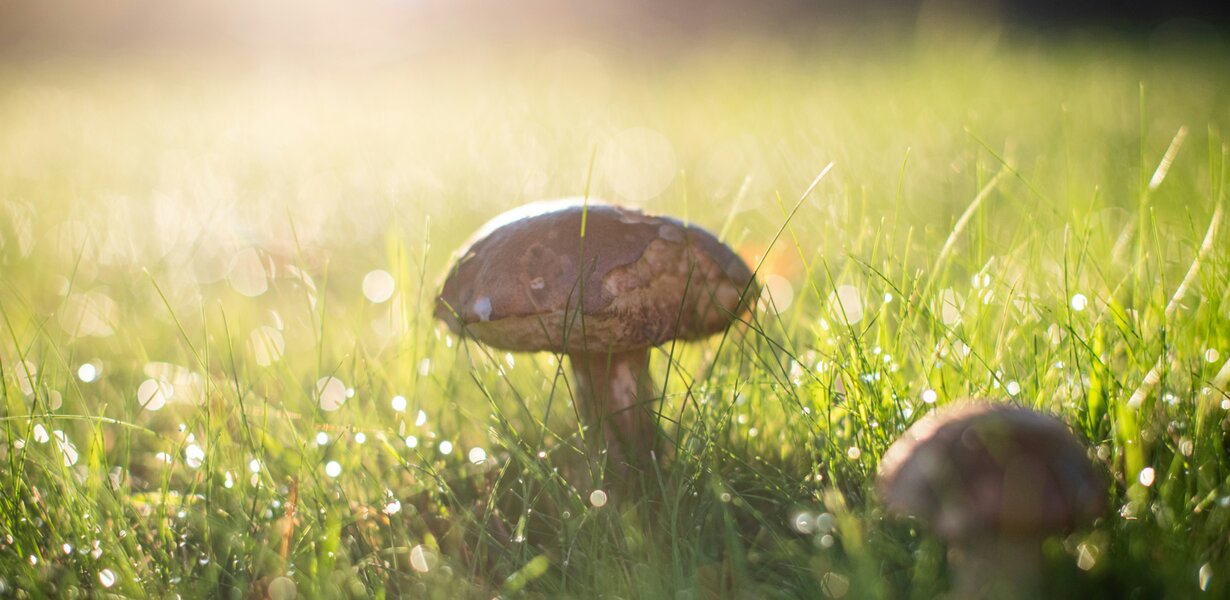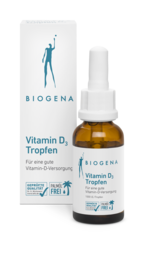Long underestimated and incorrectly labelled, vitamin D, which is actually a hormone, has been overlooked by many until now. This is hardly surprising, given that other vital substances, such as vitamin C and, more recently, niacin, collagen and biotin, have taken centre stage. But vitamin D is essential for you. It is essential for survival. An all-rounder. So the order of the day is: educate yourself and check your vitamin D levels. The question many people are now asking themselves is: which foods are rich in vitamin D, can our needs be met through diet alone, and what other sources are available? Let's find out!
Vitamin D: Why this vital substance is so important for you
Vitamin D is a real whirlwind, because the hormone is involved in many different processes in your body and interacts with almost all of your cells:
- It ensures that you can absorb calcium and phosphorus more effectively.
- It plays a role in maintaining your muscles, bones and teeth.
- It supports your immune system and your defence cells.
- It can relieve fatigue, exhaustion and bad moods.
What happens if you have too little vitamin D
With so much influence, it's clear that a deficiency of this important vital substance can affect various areas of your body:
A vitamin D deficiency makes your skeleton more susceptible to bone pain, deformities and fractures, and can lead to calcium deficiency. Muscle weakness, pain and cramps are also not uncommon. Infections, allergies and the like can throw you off track more easily if you have too little vitamin D, and you also have an increased risk of cancer. In addition, the risk of diabetes and high blood pressure increases. If your body lacks vitamin D, you may also react irritably, be restless and agitated, suffer from migraines or ringing in the ears. Hair loss can also be a consequence of such an imbalance.
Absorbing vitamin D from the sun
So you definitely don't want to risk a vitamin D deficiency. Let's now look at the ways to absorb vitamin D. And the sun is right at the top of the list. This is because your body has the ability to convert UV rays into vitamin D. Sounds perfect, right? Well, not quite. The ‘Good Health Study’ by BIOGENA warns that obtaining vitamin D purely from the sun is now usually no longer sufficient. One reason for this is our modern lifestyle. In plain language, this means that we spend too little time outdoors and too much time indoors. But in many European countries, there is simply not enough sunlight for most of the year.
Foods high in vitamin D
So what can you do? Well, there is a second option for supplying your body with this important nutrient: the right diet. To do this, however, you need to know which foods are particularly rich in vitamin D and should therefore be included in your diet.
Above all, oily fish, some seafood and mushrooms can help you replenish your vitamin D reserves. Small amounts of vitamin D are also found in eggs and some types of cheese or processed cheese, while meat, fruit and vegetables contain relatively little.
You should take a closer look at the following foods that contain vitamin D:
- Cod liver oil: While Icelanders love oil from fish liver, this vitamin D-rich food is hardly used in our part of the world. However, it also contains significant amounts of vitamin A, vitamin E, manganese and iodine. It is extracted from various types of fish, and the taste takes some getting used to.
- Eel: Many fatty fish provide a good amount of vitamin D – the frontrunner is eel, which is usually eaten smoked. However, eels are an endangered species as they cannot be farmed. Although this fish also contains valuable vitamin A, vitamin E, sodium, potassium, selenium and zinc, you should only eat it rarely – and then only products from a sustainable source.
- Sprat: This fish species is similar to herring and is also usually smoked. Sprat loves to live near the coast and is at home in the North Sea and Baltic Sea, for example. It can provide you with not only plenty of vitamin D, but also vitamin B3, vitamin E, calcium, iron and zinc.
- Herring: Herring offers a similar amount of vitamin D – as well as vitamin B3, vitamin E, iron and zinc. Whether smoked or as a tasty matjes roll, the fact is that herring is one of the foods richest in vitamin D.
- Chanterelles: Alongside fish, mushrooms are among the stars when it comes to vitamin D. Leading the list here are chanterelles, also known as egg mushrooms. They are also full of niacin, pantothenic acid, vitamin C, potassium, iron and zinc. But be careful: only collect chanterelles in small quantities for your own use!
- Champignons: Do you prefer champignons? No problem, this type of mushroom is just as good as chanterelles when it comes to vitamin D. Whether as an aromatic ingredient in a creamy soup or sauce or together with a variety of vegetables in risotto, champignons not only offer plenty of vitamin D, but also niacin, folic acid, potassium, iron, zinc and copper.
- Anchovies: If you're looking for natural sources of vitamin D, you can't ignore anchovies. Their advantage is that they are at low risk of overfishing because they reproduce quickly and in large quantities. So you can safely include them in your diet more often. What else do they provide? Niacin, zinc and iron.
- Trout: Various types of trout, such as lake trout and rainbow trout, also provide vitamin D. Salmon trout, which is a normal trout that develops red, salmon-like flesh due to its diet, also contains vitamin D. Fish also provides valuable protein.
- Porcini mushrooms: Porcini mushrooms are another source of vitamin D in your diet. However, it is important to note that, similar to chanterelles, collecting these exquisite mushrooms is only permitted for personal consumption. When dried, they are also a good source of several B vitamins, vitamin C, zinc, iron and potassium.
- Butter mushroom: Vitamin D, B vitamins, iron, zinc and copper are also found in butter mushrooms, also known as butter boletes. When dried, they are a great addition to soups and sauces and have a pleasant aroma.
Other foods containing vitamin D include: sardines, tuna, black halibut and oysters. Nowadays, plant-based milk products and juices, oatmeal and other foods are increasingly being fortified with vitamin D.
But beware: none of these foods provide you with enough vitamin D to cover your entire daily requirement – fish, mushrooms and the like only contribute part of your intake. On average, they can cover 10–20% of your needs.
Supplementing vitamin D
What does this mean for you? It means that a third pillar is needed to provide the body with sufficient vitamin D. This is where high-quality dietary supplements come into play. How much should you take? Experts recommend 20 µg or 800 IU of vitamin D per day.
However, as many people have long been deficient, higher doses of vitamin D also have health benefits – but these should ideally be based on blood values. The safe maximum daily amount is 100 µg or 4000 IU.
Conclusion
Summer, sun, vitamin D. UV rays are still the most important natural source of vitamin D. What most people don't know is that this is no longer enough. We don't spend enough time outdoors, and UV radiation is not strong enough for most of the year. To meet your vitamin D requirements, you should therefore also look into your diet. Certain types of fish and mushrooms are particularly good sources and can be used in a variety of ways. However, if you think that's all there is to it, we're afraid we have to disappoint you again: in most cases, even that is not enough. Who can turn the tide? High-quality vitamin D supplements. They are the third component of this formidable trio and can compensate for a lack of sunlight and a vitamin D-deficient diet if necessary.
Frequently asked questions about foods with vitamin D
Yes, certain types of mushrooms, such as chanterelles, button mushrooms, boletus and butter mushrooms, contain a lot of vitamin D, unlike other foods.
Milk contains small amounts of vitamin D, although the exact amount depends on the fat content and also on the feed and husbandry of the animals. Whole milk usually contains more vitamin D than low-fat milk. However, animal and plant-based milk products are increasingly being enriched with additional vitamin D.
Oatmeal may contain only small amounts of vitamin D, but it is now often specially enriched with it. Nuts are also not a natural source of vitamin D.
In addition to sunlight, which is the most important natural source of vitamin D, this vital substance can also be absorbed to a certain extent through food. Foods containing vitamin D include, above all, oily fish such as eel, herring, sprat, anchovy and salmon trout, cod liver oil, mushrooms such as chanterelles, button mushrooms, porcini and butter mushrooms, as well as vitamin D-enriched plant-based milk products, juices, oatmeal and the like.
However, as sunlight and food alone cannot usually cover the entire daily vitamin D requirement, and many people in Western countries have already developed a deficiency, dietary supplements are advisable. To optimise intake, it may be useful to measure your vitamin D levels and calculate the exact dose.
Fruits and vegetables contain very little vitamin D. The main sources of this vital substance are fatty fish, cod liver oil, eggs and certain types of mushrooms. However, these only contribute to a small part of our intake (approx. 10–20%).
No, it is not enough to rely solely on foods rich in vitamin D to meet your daily requirements. The sun remains an important source. Dietary supplements can also be useful as a supplement.
Sources:
Bopape PG, Wagenaar C, Poka M, Bronkhorst E. Vitamin D supplementation in a post-pandemic era: A narrative review. S Afr Fam Pract (2004). 2023 Oct 17;65(1):e1-e6. doi: 10.4102/safp.v65i1.5752. PMID: 37916701; PMCID: PMC10623655. https://pubmed.ncbi.nlm.nih.gov/37916701/
Tangpricha V. Vitamin D in food and supplements. Am J Clin Nutr. 2012 Jun;95(6):1299-300. doi: 10.3945/ajcn.112.039818. Epub 2012 May 9. PMID: 22572641. https://pubmed.ncbi.nlm.nih.gov/22572641/
Kilim HP, Rosen H. Optimizing calcium and vitamin D intake through diet and supplements. Cleve Clin J Med. 2018 Jul;85(7):543-550. doi: 10.3949/ccjm.85a.17106. PMID: 30004379. https://pubmed.ncbi.nlm.nih.gov/30004379/
Macdonald HM. Contributions of sunlight and diet to vitamin D status. Calcif Tissue Int. 2013 Feb;92(2):163-76. doi: 10.1007/s00223-012-9634-1. Epub 2012 Sep 22. PMID: 23001438. https://pubmed.ncbi.nlm.nih.gov/23001438/
Bouillon R. Optimal vitamin D supplementation strategies. Endocrine. 2017 May;56(2):225-226. doi: 10.1007/s12020-017-1245-1. Epub 2017 Feb 1. PMID: 28150174. https://pubmed.ncbi.nlm.nih.gov/28150174/
Bonham MP, Lamberg-Allardt C. Vitamin D in public health nutrition. Public Health Nutr. 2014 Apr;17(4):717-20. doi: 10.1017/S1368980014000081. PMID: 24580999; PMCID: PMC10282386. https://pubmed.ncbi.nlm.nih.gov/24580999/










